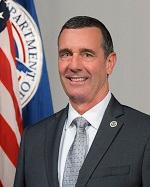
Transportation Security Administrator David Pekoske last Wednesday signed off on his agency’s latest roadmap, this one focused on open architecture to enhance current and future technologies and provide new opportunities to more vendors, increasing competition and innovation more rapidly. The new roadmap is expected to be published shortly, Pekoske told reporters last Thursday during a roundtable to discuss his latest Administrator’s Intent document, which lays out how the agency plans to accomplish its strategic priorities in the next two to…

 By
By 








